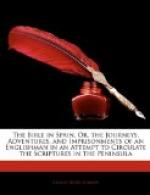We arrived close to the stupendous precipice, which rises abruptly above the isthmus called the neutral ground, staring gauntly and horridly at Spain, and immediately entered the excavations. They consist of galleries scooped in the living rock at the distance of some twelve feet from the outside, behind which they run the whole breadth of the hill in this direction. In these galleries, at short distances, are ragged yawning apertures, all formed by the hand of man, where stand the cannon upon neat slightly-raised pavements of small flint stones, each with its pyramid of bullets on one side, and on the other a box, in which is stowed the gear which the gunner requires in the exercise of his craft. Everything was in its place, everything in the nicest English order, everything ready to scathe and overwhelm in a few moments the proudest and most numerous host which might appear marching in hostile array against this singular fortress on the land side.
There is not much variety in these places, one cavern and one gun resembling the other. As for the guns, they are not of large calibre, indeed, such are not needed here, where a pebble discharged from so great an altitude would be fraught with death. On descending a shaft, however, I observed, in one cave of special importance, two enormous carronades looking with peculiar wickedness and malignity down a shelving rock, which perhaps, although not without tremendous difficulty, might be scaled. The mere wind of one of these huge guns would be sufficient to topple over a thousand men. What sensations of dread and horror must be awakened in the breast of a foe when this hollow rock, in the day of siege, emits its flame, smoke, and thundering wind from a thousand yawning holes; horror not inferior to that felt by the peasant of the neighbourhood when Mongibello belches forth from all its orifices its sulphureous fires.




